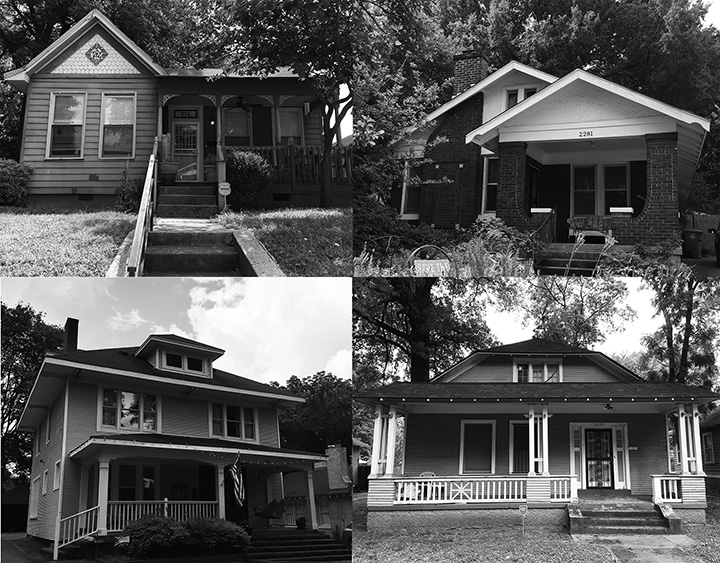After a year spent polishing up a set of proposed guidelines for a Memphis Landmarks District in Cooper-Young, committee members are ready to present their ideas and want your feedback at a public meeting set for June 22.
The meeting will take place at 6 p.m. in the upstairs conference room at First Congregational Church at 1000 S. Cooper. There will be food and refreshments and, as much as possible, answers to your questions.
The draft of guidelines for new construction and renovation has not been finalized and no date has been set for a neighborhood vote. If no more than 18 percent of property owners object by voting against the measure, the City Council will consider adding Cooper-Young to its list of local Landmarks districts.
Cooper-Young’s popularity with home buyers and rising property values have brought a host of new activity from builders lately, with nine construction permits issued in 2016-17 and more on the way. While many residents welcome the changes, some wonder if their historic neighborhood — largely developed between 1890 and 1940 — will have the same unique appeal a few years from now.
That’s what led a group of residents to begin discussions on Landmarks status in June 2016, following a suggestion made by several residents to the Cooper-Young Community Association and a series of discussions about new developments on the social media site Nextdoor.
“In my opinion, the guidelines are important because they will give the community more of a voice in determining the future development of Cooper-Young,” said CYCA president Mark Morrison, a resident of Young Avenue and a Landmarks committee member. “In addition, I think Landmarks status will help preserve the historic charm that drew all of us to CY.”
Thanks to suggestions from neighbors, several guidelines in earlier drafts have been rewritten or removed:
• Front-yard fences previously were “discouraged,” but that language has been changed. In the new draft, fences are fine in the front yard, as long as they don’t obscure the house. That means most picket and iron-rail fences are no problem, but a stockade-style privacy fence is out. Side and backyard fencing of all kinds had always been allowed, but that’s now spelled out clearly.
• Some residents thought that language encouraging “traditional” yards and landscaping could be interpreted as discouraging features such as raised-bed gardens in front yards. To avoid confusion, that language was removed entirely.
• Because so many Cooper-Young residents have been vocal in their objection to multifamily townhouses and condominiums planned on blocks filled with single-family detached houses (a five-unit development proposed at Oliver and Bruce, for instance, has spurred an advocacy group called Preserve Cooper-Young) language has been added to discourage these higher-density developments.
Much of the document focuses on new construction. While there is latitude for architects to create something original, the guidelines ask them to respect things like the height, scale and building materials of the houses around them. Garages in the front are out, but porches are encouraged.
Your house, whatever it looks like now, is “grandfathered in.” If you make an addition, make it toward the rear of the house, not out in front. Paint color would not be subject to review. Neither would anything that can’t be seen from the street.
A draft of the proposed guidelines can be viewed on the home page of cooperyoung.org.
This is the second time Cooper-Young has attempted to gain Landmarks status. An effort in August 2001 failed with 17 percent supporting Landmarks, 8 percent against and no response from 75 percent. Since then, the City Council has boosted the requirement from 51 percent support to 82 percent, and the neighborhood is using a different voting procedure, one laid out by Landmarks staff, that would deem no response as a consent vote.
“I was in support of it then, but it’s more urgent now because of what’s happening with the developers,” said Emily Bishop, a resident of Evelyn Avenue.
Back in 2001, Bishop said, the Landmarks question was sunk by residents who either felt the guidelines restricted their property rights or who may have misunderstood what issues the commission were allowed to review. Many just said they feared Cooper-Young might lose its “funky, artsy” vibe if it were a Landmarks district.
“But what’s happening is, we’re more at risk of losing that now because of the developers putting up these totally inappropriate houses,” Bishop said. “Some have been good and some have been terrible. That’s why we need guidelines for these developers who don’t understand our neighborhood.”
Cooper-Young was added to the National Register of Historic Places in 1989, a designation that restricts federal money from being spent to alter or demolish the neighborhood without a public hearing, but sets no restrictions on private property owners.
A Landmarks district would set out guidelines for new construction and renovation, which are written and approved by the neighborhood, and city staff would review construction that requires a building permit and is visible from the street to determine whether it meets the guidelines.
There currently are 13 Landmarks districts in Memphis, including three that border Cooper-Young: Glenview, Rozelle-Annesdale, and Central Gardens. Each has varying levels of review, but Cooper-Young’s guidelines were crafted to be among the least restrictive for existing housing.
The Cooper-Young Community Association is not taking a side in the current Landmarks debate, but has facilitated the process by organizing committee meetings and public meetings.



